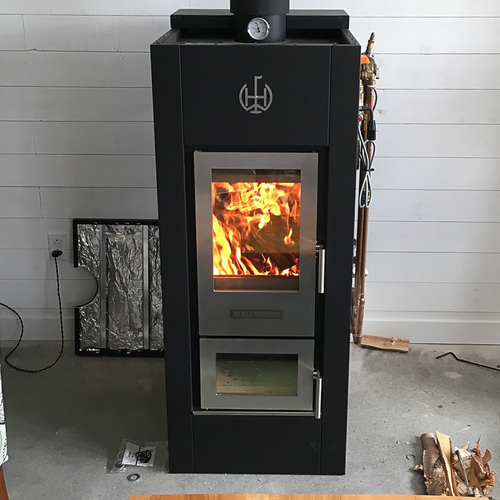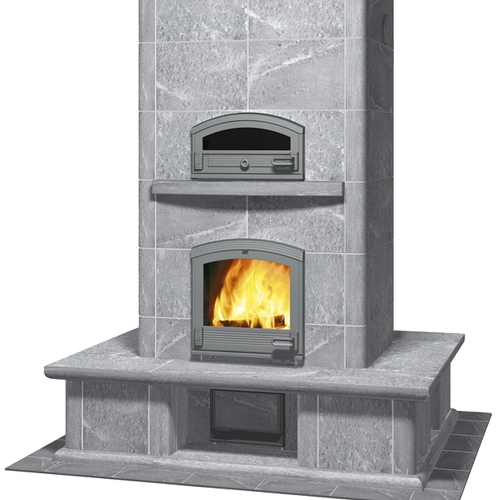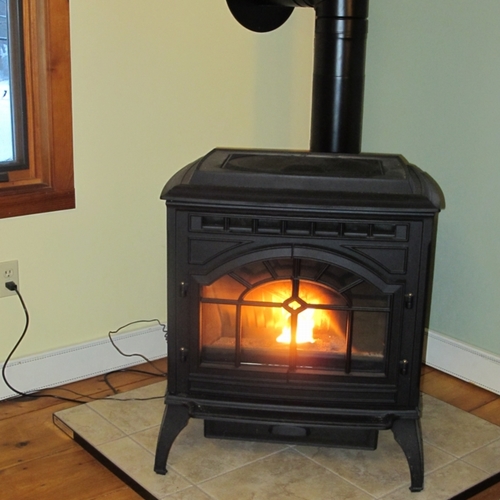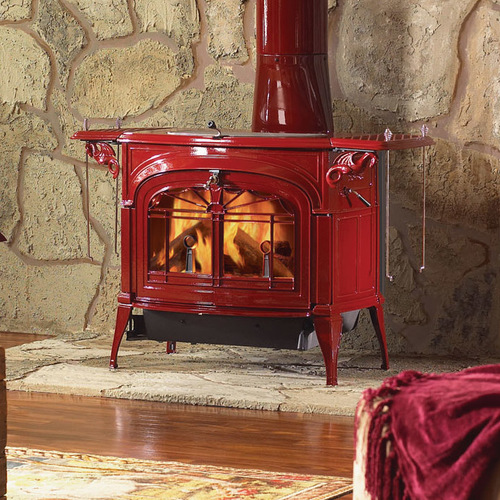Image Credit: Alex Wilson
The morning paper had yet another story about a destructive house fire — fortunately no fatalities (this time*), but the total loss of another home and another family’s belongings. And like many others, the culprit appears to have been the wood stove.
So many of the home fires we experience in Vermont result from trying to keep warm. Some have to do with faulty installation of wood heating equipment; many others result from improper operation of that equipment or management of the ash.
Burning wood safely
Having used a wood stove as a primary heating source for over 30 years, I’m pleased to report that I have never had problem, though evidence in both the house we’re moving out of and our new (old) house shows that other occupants have dealt with fires on multiple occasions. In fact, based on extensive charred wood I’ve found around the chimneys, it’s very lucky that either house is still standing.
There’s a reason that building codes call for specific set-backs from combustible materials and require insulated flue pipe wherever it extends through building components. With any installation of a wood stove, pellet stove, or any other wood-burning equipment, follow manufacturer recommendations carefully to ensure safe operation.
On the safe-operation front, a good starting point is to burn only well-seasoned wood. (I admit to a track record that hasn’t always been great in this department.) With dry wood, there will be less need to operate the wood stove with the door ajar an less need to open it up to adjust the logs during operation — both potential risks.
A big part of burning wood is about storing firewood. If, like a lot of people, you have a wood shed for storing the bulk of your wood outdoors and bring in smaller amounts for storage near the wood stove, pay attention to setback from the stove and excessive accumulation of bark and detritus near the wood stove that could catch fire from a wayward ember.
Managing ashes
Most of the wood-heat-related fires that friends of mine have dealt with have to do not with the wood stove itself, but with ashes. My wife and I store the ashes that we remove from our wood stove in several metal trash cans, and then periodically we scatter those ashes on our garden and fields. We have enough storage that we typically spread the ashes only once a year — in the spring or fall.
An experience last year showed me just how risky spreading ashes can be. I must have run out of ash storage capacity so had to spread some ashes in the spring when we were still using the wood stove. I spread ashes that I had removed from the wood stove weeks earlier, so I hadn’t thought there could possibly be hot coals, but after scattering a number of shovelfuls I noticed some threads of smoke from the grass where ashes had been spread.
I was easily able to deal with the few hot embers using patches of snow that remained on the ground, but it reminded me just how long coals can stay hot when buried in ashes. I’m almost sure those ashes had been in the ash can for at least two weeks.
Other fire risks in cold weather
It isn’t only wood heat that creates a fire risk. Gas- and oil-fired furnaces and boilers can also malfunction, and that happens more commonly in the coldest weather when they are working the hardest.
Cold weather is also when homeowners are likely to use portable electric space heaters. These can overload electrical circuits or result in shorts in the power cord, particularly if the cords are very old or damaged by pets or abrasion. Every year I hear about fires caused by electric space heaters. Examine the cords to those heaters carefully and replace as needed.
In very cold weather we also sometimes hear about homeowners who use a kitchen oven for heat. Whether gas or electric, ovens should never be used for space heating; they aren’t designed for it. When gas ovens (propane or natural gas) are used for space heat, they also introduce combustion products to the house — and all open combustion of gas introduces a lot of water vapor, which can be a problem in some situations. (I actually discourage all open combustion in houses — i.e., gas ranges, cooktops, and ovens — but the indoor air quality issues are much greater when those appliances are used for heating.)
Energy conservation is always safe
Generating heat to create warmth nearly always carries some risk. But reducing the need for supplemental almost never does.
Improved insulation, plugging holes in the heated envelope, tightening up leaky windows, and other energy conservation improvements are the best strategies for ensuring safety in houses in cold weather.
Not only are superinsulated houses safer from fire because they require less heat to keep warm, but they are also safer in the event of power outages or interruptions in heating fuel — the resilience argument I’m always making. You’ll remain comfortable longer if you can’t operate your heating system, and if you do need to operate a separate space heater, it will be for a shorter period of time.
Safe is good. And conserving energy is the best way to achieve that safety.
* The morning this article came out in our local paper, the front page of that paper had a story of a tragic house fire in my home town of Dummerston in which two people died. No word yet on the cause, but I suspect it will be related to heating.
Alex is founder of BuildingGreen, Inc. and executive editor of Environmental Building News. In 2012 he founded the Resilient Design Institute. To keep up with Alex’s latest articles and musings, you can sign up for his Twitter feed.
Weekly Newsletter
Get building science and energy efficiency advice, plus special offers, in your inbox.
















7 Comments
In an article on fire safety
You post a picture of a woodstove with firewood laying up against the wood stove and several other combustible items laying within 3 feet. Things that make you go hmmmmmmmmmmmm.
Wood against the woodstove
But why,
I chose that photo to inspire some (heated) discussion. Not a normal practice.
I'm with B.W.
The firewood is too close. The firewood should be in a bin, box, recessed nook, or iron rack, and should be located much farther away from the stove.
It may already have been
It may already have been reported here, but Montreal is looking to ban wood stoves on its territory, even modern low-pollution ones, saying they contribute too much particulate matter.
I think it would be better to instead do something about the unsafe and polluting stoves that are already in place, and to really tighten the safety screw on new installations.
Crappy chimneys and turned down woodstoves, people...
fireplaces where logs can roll onto burnable floors.... but this picture...
The firewood is too close?????????? OK...
Checking the temperature of close wood similarly stacked finds the wood at 80 degrees for closet piece. Wood needs to be held at 500 degrees to start turning into wood that will ignite at half that temperature. The wood next to the stove is there for a week or less for anyone doing such.
Not going to spontaneously combust ever... magically or because GBA says don't do it.
Sure... you could have some embers end up in the pile.... if said person is drunk or blind or is clueless as to managing fire from burning wood in one's home.
Wear your safety belt... you still die on average by 80 years on this planet... not wearing one... your average may be a few days less.
Take educated risks folks... enjoy your life... ski fast at least once per day on the mountain. Try flying... swimming... use a dangerously sharp knife next time to slice some cheese for a topping on a cracker.
Call me crazy but I walked around on two inches of ice this week... the educated way... (over shallow water in the daytime with other folks nearby....
Enjoy life.... enjoy pushing a little into the risky zones... life is more than a risk. You will die from it.
;)
aj
Educated logical risk taking is a great use for ones grey matter... besides playing fantasy football and figuring out how not to have moisture destroy crappy OSB sheathings...
OK... if one lacks the ability to stack a bit of firewood near a fireplace or woodstove and is not interested in gaining the ability then I am sure GBA is the place to come to find this obscure blog even after it slowly disappears into the archival space... yup... good luck fire newbies with that.
Martin.... ? I apologize ahead of time if me has crossed some line... sorry.
Back to one last skate before the rain tomorrow... skating on thick ice... no risk... where's the fun in that? Should I wear a life preserver and a wet suit or dry suit or have an ambulance standing by?
Somebody copy this post as I will most likely pull it after I come to my senses.... you will need it to remind me of my irreverence.
Am I being positive... negative? In need of a month in Key West?
flamin' inside
On a recent trip over the holidays I visited someone who recently
replaced a woodstove with a cute little gas-fired stove fed from
a propane tank outside. Its exhaust simply rises straight out
the top of the unit into the room air, and this is pretty much
all that the home is being heated with so it runs fairly often.
Influenced by this much time hanging out in GBA/hvac/building-
science arena, I was kinda horrified, but the interior air
didn't really seem all that bad. The unit also appeared to
be doing quite well, heating most of a somewhat sprawly single-
story ranch from the one point. They had a small booster fan
hung at the hallway ceiling to push warm air a little farther,
but it didn't seem all that needed.
It went down to 0F one night I was there, and there *was* quite
a bit of condensation on the windows that morning. I pointed
out the most likely cause. After shoveling snow and coming
back in I realized that I definitely was smelling just a hint
of gas exhaust, but it wasn't killing us yet.
I told the owner to get a CO detector into the place ASAP.
As soon as that little unit starts going out of tune, the
results could get very non-pretty. I'm astounded that such
a thing is manufactured at all, but then again there are all
those unvented kerosene stoves and gas ovens all over the world...
_H*
Response to Hobbit
Hobbit,
GBA has written many articles over the years about unvented gas-fired space heaters. Here are links to three of them:
Avoid Unvented Gas Heaters
A Ventless Gas Fireplace Doesn’t Belong in Your Home
Martin’s Useless Products List
Log in or create an account to post a comment.
Sign up Log in